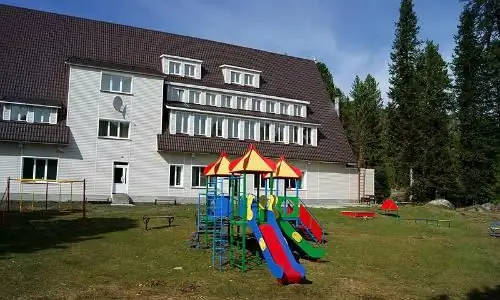- Author Harold Hamphrey [email protected].
- Public 2023-12-17 10:06.
- Last modified 2025-01-24 11:10.
Many people have probably heard the term "cluster" in the economic sphere. But not everyone knows and understands its exact meaning. This concept is also applicable to tourism activities.

Definition
Tourist cluster is an association of organizations providing services in the field of tourism. In its composition, it has small and large firms that constantly interact with each other. They are located on a single territory within the same region. The work is carried out both in the internal (travel within the country) and in the external direction (foreign travel).
Why such associations are needed
Tourism business has a significant impact on the country's economy. Therefore, its importance cannot be underestimated. For dynamically developing countries, tourism is becoming a criterion for the growth of economic indicators.
Tourist clusters in Russia today are created with the aim of creating competitive tourism services, withThis uses modern business technologies.

Composition
The structure of clusters is a hierarchical system. The management company is in charge. The state transfers to it the powers to manage certain economic territories. Relationships are based on partnership. Depending on the direction of development of the tourism cluster, financial support is provided in the required volumes.
The management company, in turn, regulates the work of the following units:
- tour operators;
- travel service agencies;
- organizations providing accommodation services (hotels, boarding houses, sanatoriums and others).
The next step in the hierarchy are:
- transfer companies;
- food establishments (restaurants, cafes, bars, etc.);
- places of leisure and recreation (parks, gyms and playgrounds, cinemas and others);
- shops with souvenirs;
- vehicle repair facilities.

Goals
At the state level, there are tasks for such associations. In this case, the tourism cluster is the concentration of tourism components in the country. That is, it is assumed that the state will become the center of world tourism.
It is also assumed that due to large formations, the work of enterprises included in the cluster willwill become more efficient. There will be a development of new directions, the inclusion of innovative systems and technologies.
The creation of a cluster creates a picture of the region and its prospects, stimulates the promotion and creation of new elements in the structure.
And cultural and tourist associations will help draw attention to the problems of preserving values. For Russia, the creation of tourism clusters will be an impetus to improve the quality of tourism services.
Varieties and types
Depending on the tourist destination, there are different types: entertainment, museum, resort, ecological and other clusters.
Regional, local, national and trans-national associations (clusters) are divided according to scale parameters. Larger ones can occupy large areas and affect adjacent structures. The formation of clusters occurs either for the intended purpose, or it is a historically established structure.

Russian experience
In July of this year, it was decided to form 17 tourist clusters on the territory of our country. Creation is planned in such regions as Dagestan, Udmurtia, Karelia, Komi, Mari El, as well as the Trans-Baikal and Krasnodar Territories. Areas for the introduction of such associations will be:
- Novgorod;
- Bryansk;
- Volgograd;
- Tulskaya and others.
Baikal and adjacent territories have good potential. They are interesting from the pointecotourism perspective. In turn, the formation of large associations in this zone will help improve the standard of living of the local population and will be an impetus for the development of industrial structures. It is planned that the Trans-Baikal zone and new tourist clusters will become the center of world tourism.
The regions of the Vologda and Moscow regions have good prospects. Ancient noble estates, monuments of architecture and history - all this can arouse interest from representatives of other states. It is only important to bring tourism to a decent level.
The creation of clusters in regions such as Karelia, Altai will also increase their tourist attractiveness in the international arena.
The development of domestic and inbound tourism is important both for the country's economy and for its international status. So far, Russian tourism is far behind the level of other countries.

World clusters
Experience in many countries suggests that large-scale integration contributes to improving the efficiency of the economy. Main centers: Asian, European (Western Europe) and North American. In European countries, the tourism cluster is a developed system.
Thanks to the interaction of organizations with the state apparatus, tourism in a country like Italy today has a modern developed tourism infrastructure. Monuments of historical and cultural heritage are carefully preserved. They have become the main attractions of the state. All modern achievements are actively used, which makestourism attractive.
For Israel, the tourism business is a key component. It brings 4% of the state's GDP. Business and medical tourism is what distinguishes Israel. In this country, the cluster is not just an independent association of individual companies, but a clear interaction of all structures, controlled by public authorities.

Principles of Placement
Regions are not equally rich in various recreational resources, so the location of cluster structures is uneven.
Most often they form in places with a high concentration of attractions, both natural and artificial.
One of the factors may be the placement in a certain area in order to raise the economic level.
Distinctive features of the cluster
- Territorially tied to a specific zone.
- The travel cluster is an open system, while the network has limited membership.
- Cluster interaction is based on social values and trust.
- Compiles organizations to create a complementary system. Creates demand.
- Based on competition and cooperation.
- Shapes a collective image of the future, common tasks.

Cluster example. Republic of Belarus
The idea of this association is the interaction of objects of different purposes. It includes catering establishments, museums, guest houses, souvenir shops. Allthe participants entered into an agreement on cooperation in the joint service of tourists. Various directions have been developed: for schoolchildren, pensioners, foreign tourists. The organizers have created a kind of set of "Wonders of Shchuchin". It included: the Malomozheykovskaya Church, which is a fortress, the Drutsky-Lyubetsky Palace, the Rakovitskaya Icon of the Mother of God. A distinctive feature of this region is the plantation of cork trees.
As you can see, the formation of such associations ensures effective interaction and development of the tourism industry. The region in which the tourist cluster is located, the cities that are part of it, will definitely receive an impetus to develop their infrastructure and improve the standard of living of the population. There is a need for a coordinated approach to activities, the formation of a financial base (by attracting sponsorship funds or state support), as well as the orientation of all components of the cluster towards self-development.






